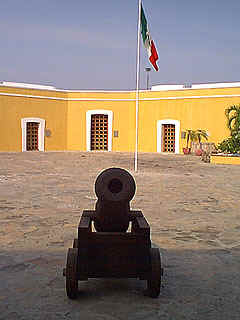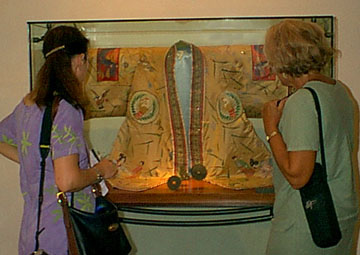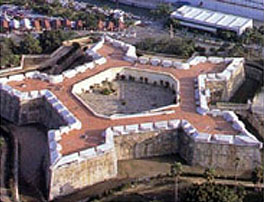NEW
JEWEL GRACES ACAPULCO'S CROWN
by
Bob Brooke
 With
all the competition from other beach resorts in Mexico, Acapulco’s
crown as the queen of Mexican beach resorts had begun to fade. Recently,
a new jewel–the restored Fuerte San Diego (Fort San Diego)–has been
added that has brightened her crown considerably. With
all the competition from other beach resorts in Mexico, Acapulco’s
crown as the queen of Mexican beach resorts had begun to fade. Recently,
a new jewel–the restored Fuerte San Diego (Fort San Diego)–has been
added that has brightened her crown considerably.
Over the years, the tired
historic fort languished in the hot sun and drew a few visitors, who had
had too much sun, away from the beaches. But after it’s recent
magnificent restoration, visitors, especially those from arriving cruise
ships, are making it a highlight of their visit.
The star-shaped San Diego
Fort Museum, situated on a hill in old Acapulco, is the one remaining
shred of history from Acapulco's early beginnings. Now this fine museum,
directed by INAH (Instituto Nacional de Antropologia e Historia), Mexico’s
department of archaeological and historic preservation, illustrates
Acapulco's past. The original rooms of the fort, now air-conditioned,
contain unique, well-lit, professional exhibits depicting life in
another era.
New Exhibits
The exhibits illustrate the Acapulco/China trade, in which ships left
Acapulco laden with Mexican silver and evangelizing Spanish priests. The
round trip to the Philippines took a year to complete and came to be
called the "Manila galleon" or the Nao de China.
This trans-Pacific trade
revolved around four main themes, and each is presented in its own
exhibition room within the eight-foot-thick walls of the Fort of San
Diego museum.
 The
"Manila Galleon" room describes the sailing ships, the
maritime routes and the rudimentary navigation techniques used by 16th
century Spanish sailors in pursuit of Asian treasure. The "Eastern
Commerce" room explores the economic motivations behind the Manila
galleon and contains antique samples of Chinese porcelain, large carved
wooden cabinets from both East and West, as well as embroidered garments
and ivory carvings. The
"Manila Galleon" room describes the sailing ships, the
maritime routes and the rudimentary navigation techniques used by 16th
century Spanish sailors in pursuit of Asian treasure. The "Eastern
Commerce" room explores the economic motivations behind the Manila
galleon and contains antique samples of Chinese porcelain, large carved
wooden cabinets from both East and West, as well as embroidered garments
and ivory carvings.
"Pacific
pirates" profiles Sir Francis Drake and tells the story of English
and Dutch pirate raids on Spanish possessions and shipping on the West
Coast, while "Evangelizing the East" relates how Jesuit and
other Catholic missionaries in the Philippines successfully converted a
country that today remains 83 percent Catholic. The room features an
impressive collection of marble and wood carvings of religious motifs
and icons commonly found in both Mexico and the Philippines.
The fort’s original
tiled kitchen now displays a stove, utensils, and methods of cooking, as
well as dried ingredients. The fort’s chapel has also been restored to
its original look, complete with statues and paintings. A bookstore at
the entrance offers a few books in English, but most publications are in
Spanish.
A 15-minute introductory
video in English on a large-screen T.V. help guide visitors through this
important national museum. Individual exhibit rooms also contain smaller
T.V.s with videos in Spanish with English subtitles. A glass floor shows
visitors remains of the first fort in several rooms. A total of 11
exhibition rooms, plus one room for temporary exhibits, tell the story
of the Nao de China.
History of Fort
San Diego
In 1565, Friar Andres de Urdaneta, an excellent geographer and valiant
seaman, discovered the direct route of return, or tournavuelta,
from the Phillippines to the Port of Acapulco. Galleons left Acapulco in
March or April arriving in June or July in Manila to avoid storm season
in Southeast Asia, returning in July or August, taking advantage of
favorable winds that allowed them to cross the sea of China, returning
east across the Pacific arriving at Cape Mendocino in California, then
turning south towards Acapulco.
On April 14 of 1579,
Spanish King Phillip II designated Acapulco as only commercial port
between New Spain and Asia. The port was intended to receive and to
dispatch Manilla Galleons, as well as a few ships originating from Peru,
Chile and Central America. From Acapulco, mules carried silks, spices
and other exotic goods overland to Mexico City and then to Veracruz for
shipment to Spain, while galleons moored in Acapulco Bay refilled their
holds with silver and other Mexican products.
A singular building with
one bastion was the first evidence of a fort in 1614. Dutch vessels led
by Admiral Joris von Speilbergen tried entering Acapulco Bay. Viceroy
Diego Fernandez de Cordoba, Marquis de Guadalacazar, ordered a fort
built to protect the Bay. The idea was to build a castle or Fort to
house residents and the ships crews chose the hill El Morro on which to
build the fort, thus preventing the enemy from getting to shore. Signal
fires warned the population of Villa de Acapulco, which had grown to
over 12,000, to take cover within the fort upon impending danger.
The Viceroy commissioned
Dutch engineer Adrian Boot to design the fortification in the shape of
an irregular polygon, which be began to build in 1615 and completed in
April 1617.
The building was unique
by its design. It applied advanced architectural concepts, thus making
it into a master work of the military engineering. Its somewhat
pentagonal structure, consisting of numerous domed rooms about a central
courtyard, permitted self-defense on all flanks. It housed 2,000
soldiers with provisions and ammunition for a year.
By1616, five bulwarks–named
King, Duke, Marquis, Guadalacazar, and Viceroy–linked by ballustrade
walls had been constructed. The fort became known as Fort San Diego
after Patron Diego Fernandez de Cordoba. In 1624, Viceroy Don Rodrigo
Pachero y Osirio, Marquis de Cenalvo ordered new works be added to the
Fort upon his arrival in New Spain. Ten years later engineer Juan de la
Torre proposed adding a moat to surround the fort.
In 1665 De Lagaspi
founded a new road from Vera Cruz to Acapulco, where Indians loaded
goods onto galleons which became known as chinas because people
believed that all oceanic traffic across the Pacific traveled to China.
By 1696, port traffic had increased and more modifications were made.
 In
1766, engineer Jose Gonzalez pointed out the fort’s vulnerability of
defense due to weak and short walls and nonfunctional bastions. However,
that became a moot point, since a severe earthquake destroyed it in
April 21, 1776. Spanish engineer Miguel Constanzo was put in charge of
rebuilding it by the King and staked out the new five-sided "pentastar"
fort in 1778. Taking five years to complete at a cost of $600,000 pesos,
the new fort had sloping walls to deflect cannonballs and two large
cisterns to collect rain water for use in the fort. It’s builders
named the fort’s five bulwarks after saints–San Jose, San Antonio,
San Luis, Santa Barbara and Concepcion. In
1766, engineer Jose Gonzalez pointed out the fort’s vulnerability of
defense due to weak and short walls and nonfunctional bastions. However,
that became a moot point, since a severe earthquake destroyed it in
April 21, 1776. Spanish engineer Miguel Constanzo was put in charge of
rebuilding it by the King and staked out the new five-sided "pentastar"
fort in 1778. Taking five years to complete at a cost of $600,000 pesos,
the new fort had sloping walls to deflect cannonballs and two large
cisterns to collect rain water for use in the fort. It’s builders
named the fort’s five bulwarks after saints–San Jose, San Antonio,
San Luis, Santa Barbara and Concepcion.
After completion of the
fort, warning salvos would alert the population to take cover in the
fort’s parade grounds. Soldiers would then roll down wooden platforms
which held the cannon. Others raised the drawbridge over the moat using
chains.
Meals consisted of salted
pork, green pozole, picaditas or squared gorditas
made of corn. Cooks supplemented these staples with seafood like robalo,
shrimp, and oysters, and tropical fruits like yellow papayas, limes, and
mangoes. They added local flavors and spices including pepper, cinnamon,
clove, red saffron, quajillo chili, garlic, cheese, chocolate to
their dishes. Though Indian woman made the meals indoors, soldiers and
workers ate them outdoors.
Though pirates
never attacked the fort, soldiers patrolled along the ramparts watching
for distant pirate ships. The
occasional roar of cannon brought terror to the population of the small
fishing village.
Fort San Diego fell to
insurgent forces in 1813 during Mexico's War of Independence after a
siege lasting several months. King Ferdinand II decommissioned the fort
in 1816.
The Museo Historico de
Acapulco within Fort San Diego is open from 10:30 A.M. 4:30 P.M.,
Tuesdays through Sundays. A small admission fee is charged. Fort San
Diego also presents a new Sound and Light show entitled "The Silent
Vigil" every Thursday, Friday, and Saturday evening in English at
8:00 P.M. and in Spanish at 9:00 P.M. Historic images telling the story
of Acapulco are projected on a screen of water flowing down one of the
outside walls of the fort. A donation of 100 pesos person is requested.
|

